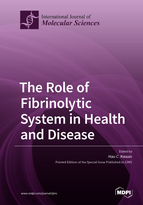The Role of Fibrinolytic System in Health and Disease
A special issue of International Journal of Molecular Sciences (ISSN 1422-0067). This special issue belongs to the section "Molecular Pathology, Diagnostics, and Therapeutics".
Deadline for manuscript submissions: closed (1 July 2021) | Viewed by 45930
Special Issue Editor
Interests: oncology; leukemia; intracranial hemorrhage; hemostatic dysfunction in acute promyelocytic leukemia; thrombosis; bleeding disorders; fibrinolysis
Special Issues, Collections and Topics in MDPI journals
Special Issue Information
Dear Colleagues,
The proteolytic enzyme plasmin is the central component of the fibrinolytic system (also known as the plasminogen–plasmin system). Originally thought to be a regulator of fibrin removal, it is now known to be more complex. It consists of several serine proteases and their inhibitors (serpins). These are involved in many physiological functions in the pathogenesis of many diseases, including atherosclerosis, obesity, cancer, immune disorders, neuronal degeneration, trauma, inflammation and aging. Knowledge of their role in cancer enables their use as a prognostic factor. Therapeutic use of various forms of proteases derived from this system has been employed in the form of thrombolytic agents. In addition, small molecules designed to inhibit many of the components of the fibrinolytic system are now available in clinical trials, aimed at the treatment of these various disorders. This remarkable development of our knowledge on fibrinolysis is the theme in this Special Issue of the International Journal of Molecular Sciences.
Prof. Hau C. Kwaan
Guest Editor
Manuscript Submission Information
Manuscripts should be submitted online at www.mdpi.com by registering and logging in to this website. Once you are registered, click here to go to the submission form. Manuscripts can be submitted until the deadline. All submissions that pass pre-check are peer-reviewed. Accepted papers will be published continuously in the journal (as soon as accepted) and will be listed together on the special issue website. Research articles, review articles as well as short communications are invited. For planned papers, a title and short abstract (about 100 words) can be sent to the Editorial Office for announcement on this website.
Submitted manuscripts should not have been published previously, nor be under consideration for publication elsewhere (except conference proceedings papers). All manuscripts are thoroughly refereed through a single-blind peer-review process. A guide for authors and other relevant information for submission of manuscripts is available on the Instructions for Authors page. International Journal of Molecular Sciences is an international peer-reviewed open access semimonthly journal published by MDPI.
Please visit the Instructions for Authors page before submitting a manuscript. There is an Article Processing Charge (APC) for publication in this open access journal. For details about the APC please see here. Submitted papers should be well formatted and use good English. Authors may use MDPI's English editing service prior to publication or during author revisions.
Keywords
- fibrinolysis
- plasminogen activators
- trauma
- immunity
- aging







